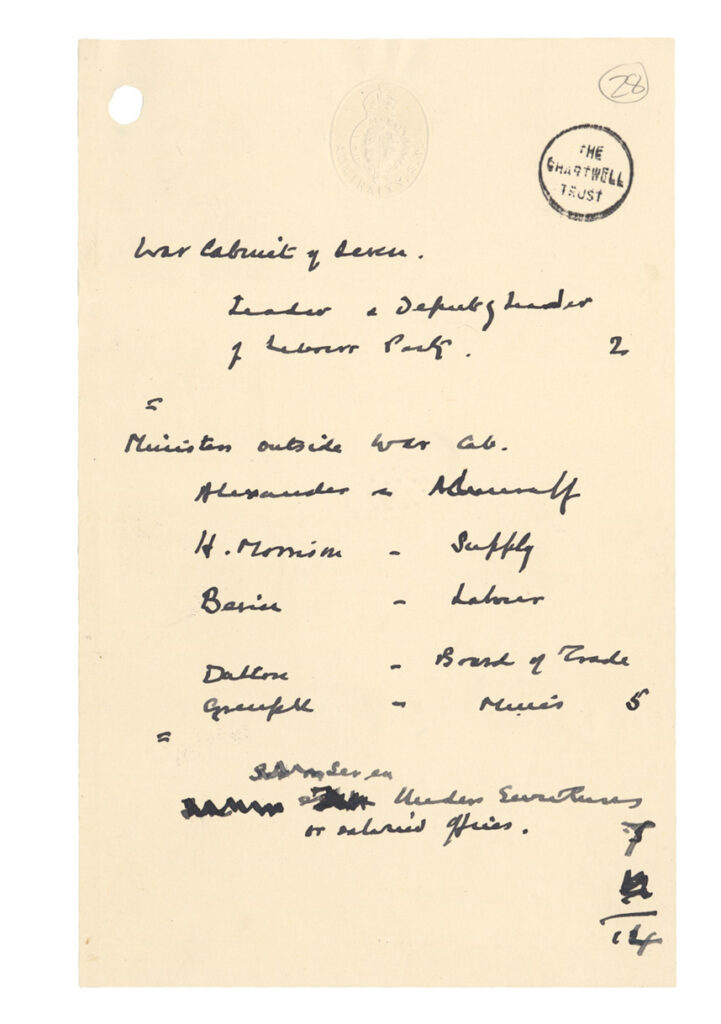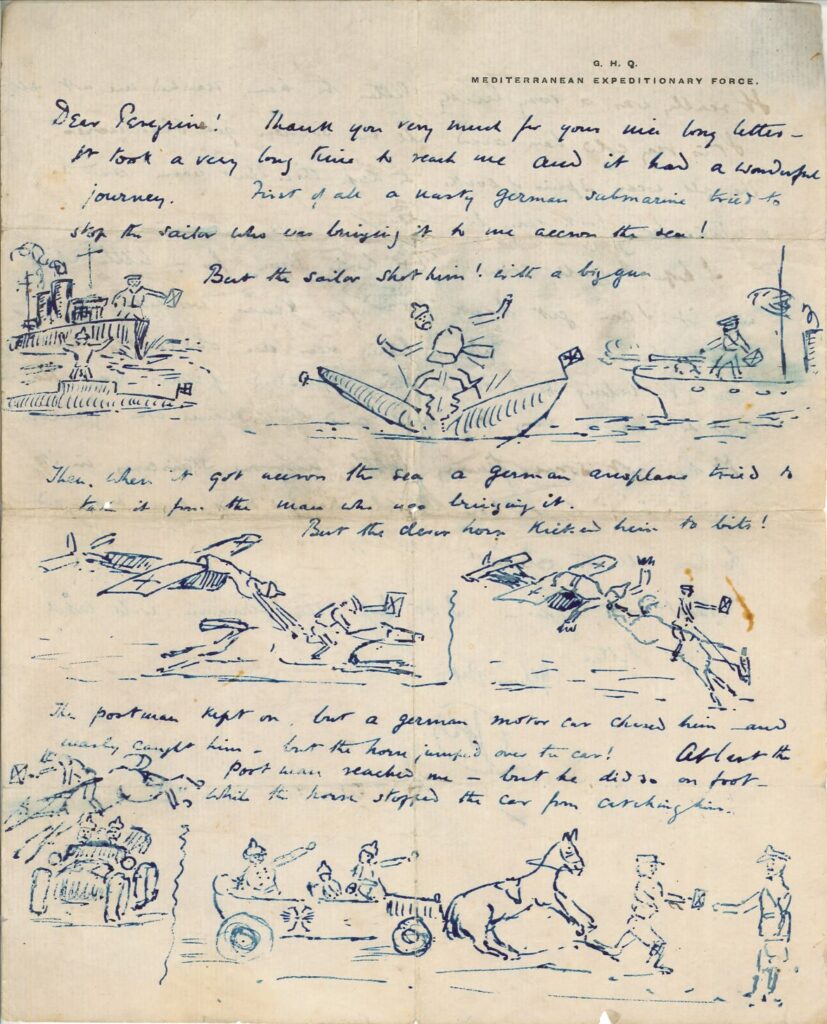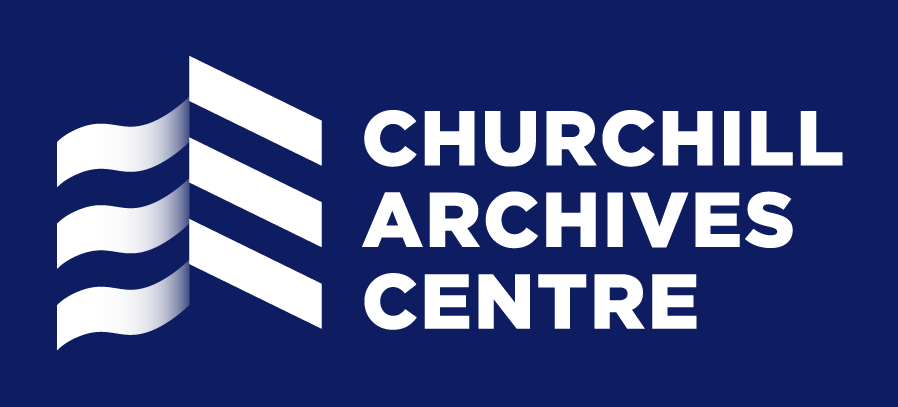Looking for Churchill
Over the years the Archives Centre has collected a mass of material relating to Churchill’s life and times.
This makes for a wonderful resource for historians, able to consult multiple different sources and viewpoints on their subject, but just the sheer volume of material on Churchill can be a bit daunting. Besides Sir Winston’s own papers there are (to date) 17 other Churchill family collections, to say nothing of over 40 related collections which have come in from Churchill’s staff and colleagues, and we are still collecting!
So how is the bewildered researcher to find their way through this Churchillian jungle? Here are a few signposts to help you: not an exhaustive list (try the Churchill filters on our Holdings Guide if you want that), but these at least will be a start, and always remember that half the fun of archives is to wander off down a promising sidetrack and find something totally unexpected!
If you are particularly looking for Churchill photographs, then see our separate guide to Churchill photographic collections.
Top family collections:
The Churchill Papers
This is the big one, 3000 boxes of Churchill’s own personal archive (though being Churchill, he scooped up a lot of official material as well). Start here for his personal and political correspondence, ministerial and prime ministerial papers, constituency files, speeches and literary work. You will also find a lot about individual family members here, including Churchill’s parents, Lord and Lady Randolph Churchill, as well as his wife Clementine and children (though they mostly have their own collections too). The thing about the Churchill Papers is that they have a very large and detailed catalogue, so any search of our holdings is bound to turn up something from this collection. References starting with CHAR refer to papers going up to 1945, while references starting with CHUR relate to the post-1945 material and those starting with CHAQ refer to additional material received from the estate of Sir Martin Gilbert, Churchill’s official biographer, between 2015 and 2017. The Churchill Papers have been digitised and published by Bloomsbury Academic and are available online to subscribing institutions at https://www.churchillarchive.com.
Highlights: Hard to pick out particular items from such a huge and wide-ranging archive, but depending on your interests, try:
CHAR 20, Official: Prime Minister, 1940 – 1945

The Broadwater Collection
This is a general family archive which has grown steadily as we have received more papers from different generations of the Churchills, which were not included in the original deposit of the Churchill Papers. Originally it was mainly an archive of photograph and press cutting albums (see separate photographic collections guide) but more recently significant items have been added relating to Lord and Lady Randolph Churchill, Winston himself, his wife Clementine and younger brother John Churchill. It is also the home of the Churchill family library.
Highlights:
BRDW V 1: There are some particularly precious letters in this section, including an account of the Battle of Omdurman written by Churchill from the Sudan in 1898, Letter from Churchill to Colonel Sir Ian Hamilton, 1898-09-16 and a letter to his mother in 1916 from the Western Front, Letter from Churchill to Lady Randolph Churchill, 1916-01-29.
BRDW IV 2/2-3: Two albums from the Boer War relating to the hospital ship Maine which Lady Randolph Churchill raised funds for and sailed with to South Africa, Photographs, 1870 – 1920.
The Papers of Clementine Churchill
The place to look for the key relationship of Churchill’s life, with his beloved wife. Much of the correspondence between the two of them can be found here (though, typically, there are many similar letters in the personal sections of the Churchill Papers). Clementine also kept an invaluable series of both personal and official photo albums (see separate photographic collections guide) and had her own separate correspondence, where she not only documented her own extremely busy life, but picked out highlights from her husband’s career as well. This is also a good place to find details about the management of Chartwell, the Churchill family home.
Highlights:
CSCT 1, Letters from Lady Churchill to Sir Winston Churchill, 1908 – 1963. Clementine’s letters to her husband, from the time of their engagement up to until a few years before Churchill’s death. His letters to her can be found in CSCT 2.
CSCT 3/33, Air Raid Shelters, 1940 – 1944. A file from Clementine’s own correspondence, on her work to improve air raid shelters in the London area during the war.

The Papers of Randolph Churchill
The papers of the Churchills’ only son. Quite apart from the sections on Randolph’s somewhat troubled political and journalistic career, this archive includes a particularly strong correspondence series on his difficult relationship with his family, and a large amount of literary papers. Over half of these relate to Randolph’s work on the first few volumes of the official biography of his father, including a lot of photographs which he collected for use in the biography, many of which remained unpublished (see separate photographic collections guide). As with his mother Clementine, you will find correspondence with and about Randolph in the Churchill Papers too, and his stormy relationship with his parents is also documented in the diaries of his deeply disapproving younger sister Mary.
Highlights:
RDCH 1/3, Family correspondence, 1916 – 1970. Correspondence between Randolph, his parents, his first wife Pamela (later to become Pamela Harriman) and their son.
RDCH 1/2/40-41, Letters from Thomas Mitford to RSC, 1928-01 – 1935-06. Randolph’s correspondence with his fellow Old Etonian Tom Mitford in the 1920s and 30s, at a time when Mitford was living in Berlin and becoming increasingly interested in the Nazi Party. Other files in this series include Randolph’s correspondence with his equally sharp-tongued friend Evelyn Waugh, Correspondence with Evelyn Waugh, c 1943-68.
The Papers of Sarah Churchill
The papers of the Churchills’ second daughter, the actress and dancer Sarah Churchill. Like her brother Randolph, Sarah did not have an easy life. She was married three times, and suffered increasingly from the effects of personal bereavements, illness and alcoholism, but her correspondence in particular is a good and lively source, both for her own life and that of her family.
Highlights:
SCHL 1/1, Letters from Sarah Churchill to Clementine Churchill, 1921 – 1977. We have more than 50 years of Sarah’s letters to her mother. For those researching Winston Churchill, Sarah’s descriptions of her travels with her father to the wartime conferences in Cairo and Teheran, 1943 and Yalta in 1945 and to Lake Como in the immediate aftermath of the 1945 election defeat, provide invaluable insights.
The Papers of Lady Soames
One of the best and most comprehensive of the family archives comes from the youngest of the Churchill children, Mary. A teenager on the outbreak of war, Mary adored her parents, and as a girl clearly thought her father could do no wrong (though she is slightly less uncritical when it comes to her mother). She was also deeply attached to her siblings, with the possible exception of Randolph, though their relationship does seem to have improved with age. In later life, Mary became an accomplished writer, producing an award-winning biography of Clementine, and highly successful editions of both her parents’ correspondence and her own wartime diaries. Source material for all these works and more can be found in her archive, as well as a wealth of papers from her busy life as the wife of the diplomat and politician Christopher Soames, patron of many Churchill-related organisations, and also her spell as Chairman of the National Theatre, 1989-95.
Highlights:
MCHL 1/1, Diaries, 1939 – 2013. Mary kept diaries for much of her life, and those dating from the war years in particular are a superb source. She joined up in 1941, serving with the ATS, but stayed with her parents up until then, and even once she was a serving officer Mary, like her sister Sarah, accompanied her father to several of the wartime conferences, to Quebec in 1943 and Potsdam at the end of the war.
MCHL 5, Literary, 1847 – 2012. This series of Mary’s source material and research notes for her books takes up nearly 100 boxes by itself, and is particularly strong on Clementine, Mary’s own wartime years, including a lot of original correspondence with her family, and also her photographic sources (see separate photographic collections guide).
Papers accumulated by Henry Winston (Peregrine) Churchill
The archive of Churchill’s nephew Peregrine might seem a little off the beaten track, but it actually holds some very good material, as in later life Peregrine took on the role of family historian. Aside from the Churchill Papers themselves, it is one of the best places to look for the letters of Churchill’s mother, Lady Randolph, to her sons, mainly to her younger son, Peregrine’s father Jack, and also for correspondence between Jack and Winston.
Highlights:
PCHL 8/7, Photographs relating to Winston Churchill and family, 1899 – 1969. Original photographs of the family, including Winston learning to fly in 1913 and playing with his son Randolph as a baby.
PCHL 4/9, Correspondence with Peregrine Churchill, 1915-47. This file includes an enchanting illustrated letter sent by Jack to Peregrine when he was a small boy, written while Jack was serving on the Western Front, and describing the various hair-raising adventures which a letter from Peregrine had gone through on its journey to reach him.

Papers relating to Lord and Lady Randolph Churchill
Churchill’s parents are almost the only members of the family who don’t actually have their own collections. We used to have Lord Randolph’s papers, but these are now at Cambridge University Library, Lord Randolph Churchill: Correspondence and Papers. However, you will find correspondence and papers relating to both Lord and Lady Randolph throughout the other family collections, particularly in two sections of the Churchill Papers ( CHAR 1, Personal, 1884 – 1945 and CHAR 28, Acquired Papers, 1690 – 1960), plus the Broadwater Collection and Peregrine Churchill’s archive (see above for these), and the papers of the 7th Duke of Marlborough.
Top Churchill-related collections:
Chartwell Manuscripts
A bit of an odd one, this: it consists of a collection of disparate items which were either sent to Churchill, or were amassed after his death in tribute to him. The archive came from Churchill’s home at Chartwell, now run by the National Trust, but was never displayed within the house itself. There are a great many gifts, certificates, honorary degrees etc, as well as a large number of memorial books signed by people throughout the world when Churchill died. For those interested in Chartwell, there are also a number of files on the administration of the house in Churchill’s time.
Other Deposited Collections Relating to Sir Winston Churchill
Another real mixture, but with some key items to look out for. This archive was always separate from the Churchill Papers because it has been collected over the years from many different sources, not directly from the Churchills themselves. It includes (very) varied sections of correspondence, papers on Churchill’s experiences in the Boer War, a large section on his funeral, a lot of rather random photographs (see separate guide to Churchill photographic collections) and miscellaneous items and a large collection of audio recordings, including some of Churchill’s speeches.
Highlights:
WCHL 2/7, With Headquarters I Escape from Pretoria, 1899-12. Churchill’s own account of his escape from captivity during the Boer War, written up for the Morning Post.
WCHL 11/1, Nelson’s Prayer Book. The first of a number of items relating to Nelson, always a hero of Churchill’s, which were gifts from friends and admirers.
Churchill Oral History
Practically our only Churchill-related collection which actually lets you hear the voices of those who knew him. It includes a series of interviews recorded at the Archives Centre with Churchill’s former staff, mainly his secretaries and assistants, Interviews with former staff of Sir Winston Churchill, 1978 – 1986. There is also a more wide-ranging series of recorded talks and interviews from Churchill’s friends and colleagues in CHOH 3, Speeches and interviews relating to Winston Churchill, the foundation of Churchill College, Cambridge and other subjects, 1965 – 2012.
Churchill Press Cuttings
A very large (82 boxes’ worth) and comprehensive series of cuttings covering most of Churchill’s career, from 1919 until after his death.
Churchill Press Photographs (see separate list)
The Papers of Sir John Colville
We have the archives of twelve of Churchill’s secretaries (as well as several literary assistants, a protection officer and a cook), but of these the best known is probably Sir John ‘Jock’ Colville. He was Assistant Private Secretary to three Prime Ministers in a row: Chamberlain, Churchill and (briefly) Attlee, and was initially rather dubious about Churchill, having been a loyal supporter of Neville Chamberlain. After a while, however, he became close to the whole Churchill family, and later played a key role in the foundation of Churchill College. What Colville’s archive is primarily known for is his remarkable series of highly detailed diaries, kept from 1939 to 1957 (you wonder how on earth he found the time). These are especially valuable because he shouldn’t have been keeping a diary at all during the war years, because of the security risk: at one point he scratches out an entry on the projected date for the D-Day landings, realising rather belatedly that this might not be a good idea.
Though Colville later published an edition of his diaries, in The Fringes of Power: Downing Street Diaries 1939 – 1955, that was very much the edited highlights, as indeed nearly all published diaries are, as it cut ten original volumes down to one (though given Colville’s handwriting, a printed version does sometimes come in useful).
The Papers of Patrick Kinna
Kinna, the second in our list of secretaries, was Churchill’s personal assistant and short hand typist from the Atlantic Charter meeting in 1941 (when it was thought that a man might be more suitable than a woman, given the sailors’ language) until the end of the war. His small archive is particularly good on the wartime conferences, with several files of contemporary photographs, papers on staff arrangements and some interesting souvenirs.

The Papers of Sir John Martin
Even more than Patrick Kinna, John Martin was with Churchill on his travels throughout the war. As his Private Secretary (and Principal Private Secretary from 1941), Martin accompanied Churchill to Washington, Cairo and Moscow and was present at almost every summit meeting from the Atlantic Charter meeting in 1941 to Casablanca, Quebec and Teheran in 1943, and Yalta in 1945.
Like Colville, Martin kept a diary when he shouldn’t have done, though in this case we only have selected extracts, rather than the whole thing. We also have Martin’s letters home from his travels, and he later kept up a useful correspondence with historians about his memories of working with Churchill.
The Papers of Nina, Lady Onslow
Just to redress the gender balance a little, the fourth of our secretaries is Lady Onslow, formerly Nina, or ‘Jo’ Sturdee, who was one of Churchill’s personal secretaries both during and after the war. Only in her early twenties when she joined the Churchill team, Jo Onslow’s archive mainly consists of her lively letters home to her family, from 1944-53. Here you can find accounts of what it was like to work for Churchill, Jo’s impressions of her colleagues, the Yalta conference in 1945 and preparations for and reactions to Churchill’s ‘Iron Curtain’ speech in 1946.
The Papers of Lettice Marston
More diaries, this time from another of the personal secretaries, Lettice Marston (later Shillingford). Lettice’s main task was helping with Churchill’s literary work (chiefly his war memoirs) but she was also part of the team taking down his speeches and working on his vast correspondence and later ran his constituency affairs. Luckily for us, she also kept a small but highly detailed series of personal diaries in her early years on the Churchill team; these only run from 1946-48, but Lettice writes down everything that happens.
The Papers of Sir George Harvie-Watt
Harvie-Watt’s papers are rather different from those of our other secretaries, as he was Churchill’s Parliamentary Private Secretary, rather than his Private Secretary, so a political appointee and MP instead of a civil servant. It is the PPS’s job to keep their minister aware of what’s going on in their party, so Harvie-Watt’s archive chiefly consists of reports on the House of Commons, particularly his observations on the mood of MPs and their reactions to Churchill’s speeches, policies, and events during the war.
Katharine Thomson, Archivist, January 2024

